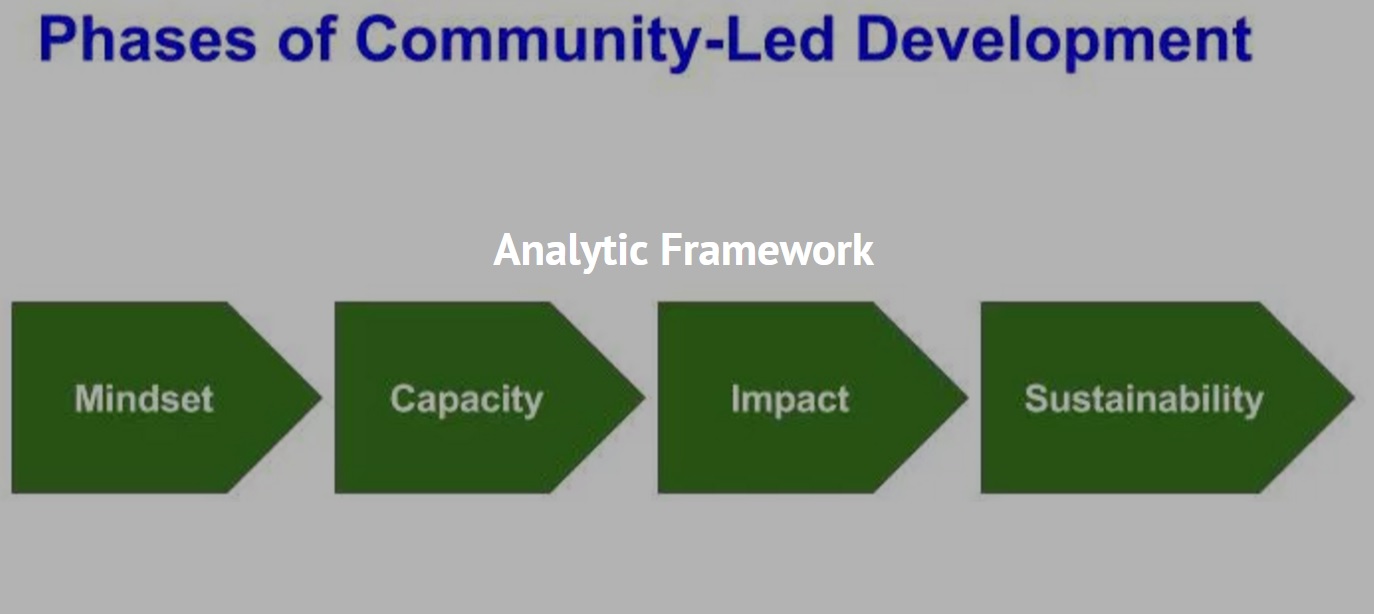Our latest review of those methodologies highlights at least 14 distinct categories of intervention—across four phases shown in the table below—to empower communities to successfully take charge of their own development on a sustainable basis. We intend to develop and use this framework to study, compare and share approaches and best practices.
CLD is primarily distinguished from other community-based programming in that it has:
Principles and Values: CLD interventions embody and espouse a clearly-articulated set of principles.
Structure and Process: CLD empowers communities with a well-tested, systematic sequence of steps, skillfully managed and measured. CLD practitioners recognize that ad hoc training workshops can actually be counter-productive, raising expectations without delivering change.
Download the Analytic Framework for Community-Led Development
| Mindset | Capacity | Impact | Sustainability |
|
Gender Vision Strength/ confidence/ assets Social Mobilization |
Leadership Governance Skills Group Formation Linkages |
Social Cohesion Participatory Planning Social accountability “Data for the people” |
Legal existence Resilience Graduation |
- Phase One — Mindset: CLD begins by transforming the mindset of both citizens and government representatives from seeing people living in conditions of hunger and poverty as “subjects / beneficiaries” to “change agents” and rights-bearing, active citizens. This includes:
- Gender: CLD facilitation is preceded by a solid gender analysis, and strongly intervenes to empower the voice and agency of women and girls while transforming discriminatory attitudes and behaviors that have held them back.
- Vision: While some participatory processes are based in problem-solving, CLD focuses on empowering individuals and families to identify and stand for a vision of what they want to achieve. Problems are endless, and can reinforce a sense of helplessness, while identifying a vision begins to reawaken people’s spirit of self-reliance.
- Strengths, Confidence and Assets: Foster the ability of communities to assess and recognize their strengths, skills and assets as a platform for future progress.
- Social Mobilization: Mobilizing the voluntary efforts of all citizens to take action to achieve priorities within the vision.
- Phase II – Capacity: As people begin to gain voice, agency and confidence in their ability to take action to improve their lives, they need to begin building the “social infrastructure” necessary for sustainable social and economic progress in all areas of life.
- Leadership: CLD provides opportunities for all citizens to step forward and develop the skills of transformative leadership, that is “leadership with” rather than “leadership over.”
- Governance: CLD facilitates processes to improve the effectiveness, transparency, accountability and participatory decision-making of the level of government closest to the people, and to ensure that the community is well-resourced and represented in upper tiers of government.
- Skills: As people begin to take organized action, they become a strong demand for skills training — in budgeting, livelihoods, project management, legal and human rights, health and nutrition.
- Group Formation: CLD facilitates individuals to form groups, associations, cooperatives, teams and other forms of community-based organizations for collective action and advocacy. In many cases, these associations are federated upwards for impact at higher levels of society.
- Linkages: CLD supports communities to forge relationships with existing resources (expertise, organizations, funding and public services) to support their development activities.
- Phase III – Impact: Once communities are organized, they are equipped to achieve measurable progress in health, education, livelihoods and all aspects of their vision. The CLD process includes:
- Participatory Planning: CLD facilitates communities to establish a regularized and inclusive process for multi-sectoral planning, setting aspirational goals and planning their own solutions.
- Social Cohesion: CLD overcomes rivalries and other divisions (such as party, religion, ethnicity or distrust across neighboring villages) that thwart progress.
- Social Accountability: CLD supports regularized processes such as public forums, at which local government can demonstrate transparency and accountability and citizens can review progress on goals .
- Data for the People: CLD supports communities to generate and access timely, locally-relevant data that informs priority-setting and empowers progress tracking.
- Phase IV — Sustainability: CLD is designed to restore citizens over control over their own lives and destinies. The process includes specific actions to ensure that this outcome is sustainable, and resilient to political, economic and other shocks.
- Legal Existence: The social infrastructure established by CLD needs legal incorporation to ensure it sustains beyond any personality or outside partner. It must either be fully integrated into the local system of government, or established as a legally incorporated co-operative, local development association or other democratically controlled structure.
- Resilience: The challenges of climate change have underscored the fact that resilience to shocks is a community-level characteristic. Local communities must have a regularized process of disaster preparedness and risk-reduction.
- Graduation/Exit-Strategy: From the outset, CLD identifies criteria for a clearly-defined end-point to the facilitation process, often marked with a big celebration of the achievement of sustainable self-governance!
